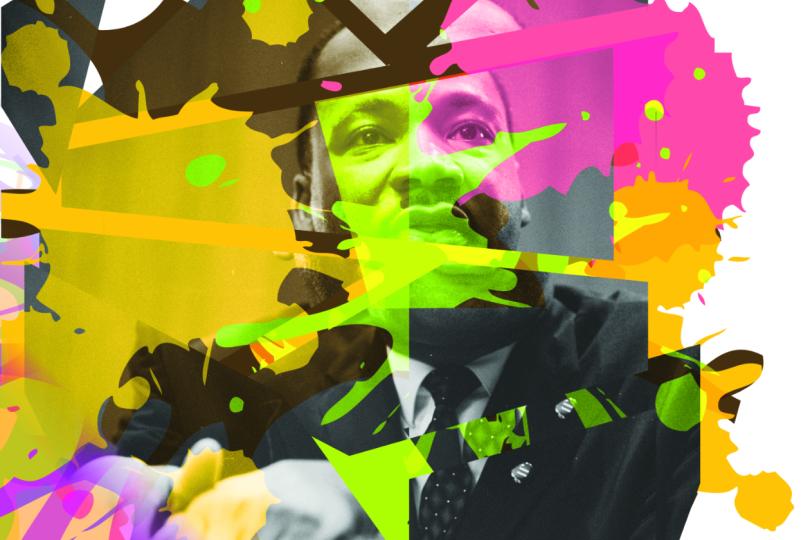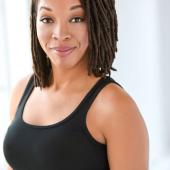There is more room in the body

On Saturday May 12th I attended Mixed Blood Theatres Living The Dreamevent. It was a day of panels, workshops and performance that sought to explore strategies to undo racism through the arts. I learned about this event a month prior and knew from the moment I saw flyers that I neededto go. I snagged the cheaper early bird registration tickets but they also had free tickets to honor their commitment to radical hospitality. I set my alarm early for a Saturday, registration started at 9:30 a.m., and I was sure to grab my London Fog Tea Latte as I knew I needed to prep myself for a full day of exploration and discovery. Walking into the theatre I was greeted by familiar faces and new faces that I would later connect with. Artists of all disciplines and backgrounds gathered together. The event encouraged POCI artists as well as Allies of those communities to attend, but it stressed that the spaces would cater to those artists identifying as POCI.
We gathered to sing “Lift Every Voice” the black national anthem. Leading us in song was the powerful and compelling Jayanthi Kyle who can easily shut a house down with her soothing vocals. I loved that even when she tripped up on the words she asked for assistance from the community to sing again. A perfect metaphor to what would unfold through the rest of the day. Two religious leaders (one being Unitarian) lead us with centering words that focused our minds on what we were about to partake in. We reached across the theatre to physically connect with one another, “there is power in connection” one pastor stated. We then bowed our heads, closed our eyes, honored the sacred and stolen land that held us up and spoke the names of ancestors into the space. It was beautiful and powerful.
Awakening us from our centered state, yet still keeping us focused and compelled, was the ever so vivacious Mankwe! It was my first time seeing her perform and “preach” (I’m not sure what words to use, you have to see it for yourself). Starting from the audience, she whaled and played with her vocal flexibility. The unexplainable sounds encompassed her full authentic voice. All of it! The pretty sounds that remind us of princesses and the spirit evoking sounds that remind me of mourning singing. It was raw and what I loved the most, it was non-eurocentric and on it’s own terms. She swayed- almost floating- to the stage and sat on the edge. Settled in one spot she manifested a world of movement, voice and story that took the audience beyond her stagnant space. Memorable phrases she sang to us where:
“do we have to suffer to undo the nation”
“what dreams do we see, what dreams do we struggle for”
“we can’t do it alone we need each other”
and my favorite,
“Ancestors in the water, we the water now, protect the water”.
She had us captivated and curious. Once she finished, we were introduced to a powerful panel of POCI artists and their profound words on thriving as an artist of color.
The Panel touched on grant writing and access to arts funding as a POCI artist especially those running grassroots organizations. They explored identity and how they have been forced to define or redefine their artwork by colonial forces. The panel included new Ten Thousand ThingsArtistic Director Marcela Lorca, the Director of Mizna(an Arab arts organization) Lana Barkawi and Native dancer Rosey Simas. The Panel was lead by David Mura who also added insights in the conversation. Golden nuggets I took away from the panel included the understanding of the pressure from eurocentric art forces to define (therefore colonizing) POCI artistry. Lana stated that Arab arts is always seen as something of the past but that there is indeed contemporary Arab art that deserves spotlight and recognition. It is necessary for undoing some of the societal antagonizing of Arab peoples.
I found the true gold of the conversation came from the topic of funding and grant writing. Each panelist, and the facilitator, expressed the disparities facing POCI artists and organizations when it comes to funding. They spoke of the distrust funders seem to have for small POCI organizations and how very often, one’s culture and heritage must be set aside to fit within their rigid boxes. Rosey expressed how being indigenous, it is culturally instilled in her to have integrity, so when she asks for money, she asks for what she needs. It is frustrating for funders to tell her that she asked for too much and it further proves the distrust and impossible limitations certain grant organizations have set up.
It is structural, it is systemic, and much like our society that experiences structural and systemic racism, theatre as an institution is no stranger. David Mura stated, “Systemic Racism and classism work in the arts the same as it works in society. Not simply individual prejudice and bias but seemingly objective rules and criteria that systemically disadvantage POCI and low-income artists”.
The panel really got me thinking, if we are to thrive as POCI artists, can we truly stick to what is true to us and our unique yet universal artistry? Or, must we shed pieces of ourselves to fit within the eurocentric confines that permit us to receive the financial lift that gives our work longevity. This is why we need to strategize and take action when it comes to undoing racism within the arts. Structural powers will keep the marginalized artists poor and the big institutions rich and richer.
Once the panel ended, participants broke out into workshop sessions which ranged from poetry, dance and song to kite and mask construction. Facilitators included; Jayanthi Kyle, Maria Asp, Courtney Cochran, Su Hwang & Sun Yung Shin, Ifrah Mansour, Marcus Young & Christopher Harrison. I personally decided to create masks with visual artist Christopher Harrison. We constructed masks from magazine collaging and cardstock paper. I loved looking through magazines older than myself and cutting out pictures and words that spoke to me. I especially enjoyed conversing with artists and art educators about social justice and arts with youth. We shared our work and experiences which turned into a sharing of strategies. As the workshops came to an end, I heard from other participants what their thoughts and experiences were:
“It was great to share in this joyful experience with seemingly small ways to practice being kind and supportive” -Mariah Larkin on Kite construction with Ifrah Mansour
“what I liked most was connecting with artists I don't normally cross paths with and allowing my extroverted Theatre self to be an introvert for a day” -Crystal Spring on Poetry with Sun Yung Shin and Su Hwang
“it was captivating and relaxing to be out of your body” -Catherine Campbell on dancing with Marcus Young
One participant mentioned how they reflected on self-expression being Joyful and not for people to consume and another recalled the words their facilitator instilled in the workshop which was “Love your music, move honestly and fearlessly, feel what you feel”. Overall, I could see that people bonded together by taking the small risk of learning something new.
We were brought back to singing by the majestic Jayanthi, leading us in original and historic songs of protest. She reminded us that singing is healing and that we should sing more often. She powerfully proclaimed that if you have a speaking voice you have a singing voice! And if you’re not using it then you are not allowing yourself to heal in the ways that you could be healing. Other enchanting performances include Ethiopian music poetry and dance by Surafel Abebe and Eyeyu Bele, and original spoken word poetry by local poet Sisco; whose words challenged our ideas of what is worth fixing in this society stating, “how can we fix something that has been broken for so long? Is it even worth fixing to you?”.
To close our day, we were graced by a visit from Resmaa Menakem author of “My Grandmother’s Hands”. He came to speak on his book and his work dealing with racial trauma and the physical body. His book conveys how healing racial trauma should first begin with the body as our cellular memory holds our ancestral traumas no matter our ethnic background. We listened and moved around doing partner activities that allowed us to listen to our bodies fight flight and flee sensations. Resmaa reminded us that this is not a defective trait but a protective trait. And sometimes we see traits that are results of historical trauma within a community and we recognize it as a cultural trait if not a personality trait.
Once his hour was up I was able to track him down to ask how his work connects with the goal of the day, undoing racism through art and he graciously replied, “We can get really cognitive in the arts, over cognitive. We should slow it down to sense, track and witness through the body not the head. There is more room in the body”. I took this to mean that when art is intentionally meant to dismantle white supremacy and systemic racism, let it also be for the body’s sake. To allow someone to feel the dismantling within themselves and not limited to the cognitive thoughts of dismantling the powers that be.
Art and society have a unique relationship in that they influence and shape each other. In our world, the white body is seen as worthy, beautiful and rich. I have to believe that this is reflected in the art that is supported the most and perpetuates whiteness and eurocentric standards. If this society was built for the white body to succeed and all other bodies are to be measured by those standards, then those rules still apply in the world of the arts. Therefore, I believe that art by POCI individuals and organizations has no chance at undoing structural powers if they are always measured by those eurocentric standards. It was asked earlier in the day, for individuals to raise their hands if they were funders or donors partaking in the days events. Nobody raised their hand and I am pretty sure every artist in the space had some of the same thoughts. POCI individuals did not invent racism or structural disparities. So why should it be put on us to undo it? When we provide space to figure these historical messes out, it is important for those who have power and access to show up without taking up space.
I asked event curator Lia Rivamonte what prompted her to make space for such an event in the Twin Cities. Below is her reply:
“There are a few things that inspired me to create this event: I feel there exists a hunger for such gatherings to insulate the IPOC community against a particularly hostile environment. I have been working as an artist and as an arts administrator since the 80's. I know that for artists of color, while opportunities have increased over the years, it has often been due to the artists' own extraordinary initiative--and not necessarily because funders and the well-supported arts organizations in the area have seen what is possible. Just as our panel remarked, it isn't always easy to jump through the hoops, and we have to wonder why it's been so hard in the first place. Certain "standards" exist and not everyone meets them nor have they felt it good for their art to meet standards that do not relate to their artwork or traditional cultural and/or ethnic or racial identities--who they are as artists. Mixed Blood was founded in the "spirit of Dr. King's dream." I felt it appropriate that we mark the 50th anniversary of King's assassination in a way that made sense as a theatre, as artists. As artists, I feel, we have a singular role in society to speak the truth, to connect with other humans. As artists of color, we are burdened with even more of an obligation to challenge the status quo. Finally, as a spiritual person, I want to be able to live my values out in the world- (as do we all!) - racial equity, social and economic justice, and inclusion are core spiritual values for me. Creating such an event easily aligns with these values.”




